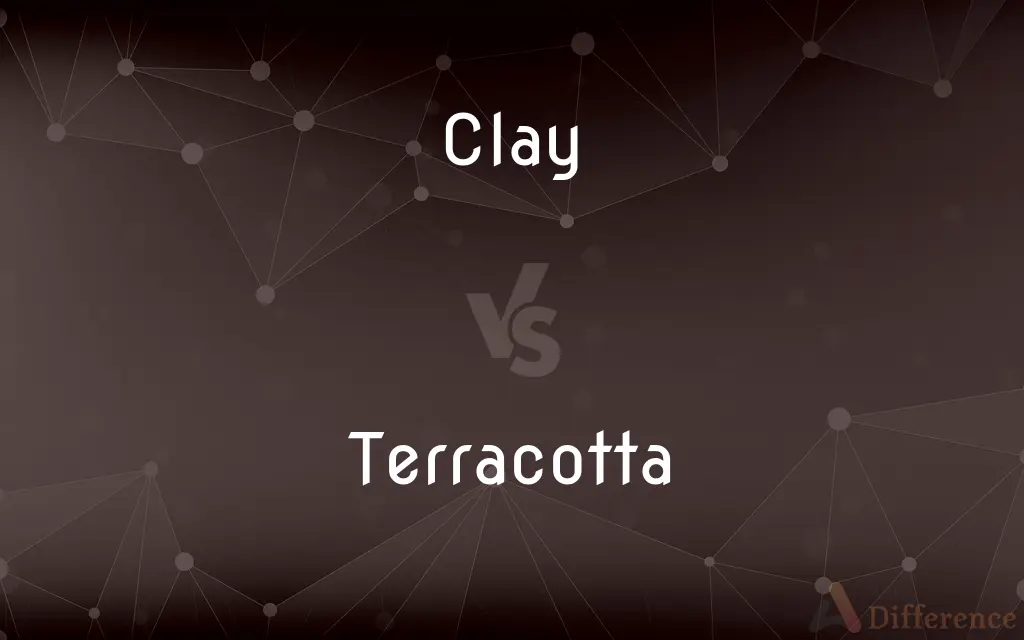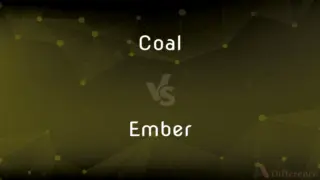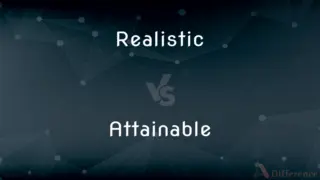Clay vs. Terracotta — What's the Difference?
Edited by Tayyaba Rehman — By Urooj Arif — Updated on March 19, 2024
Clay is a natural, earthy material used for making pottery and bricks, while terracotta is clay that's been molded and baked, known for its reddish-brown color.

Difference Between Clay and Terracotta
Table of Contents
ADVERTISEMENT
Key Differences
Clay is a natural, pliable earth material composed of minerals and water, found in various parts of the world. It becomes moldable when wet and hardens upon drying or firing, making it a fundamental material in pottery, sculpture, and construction. Terracotta, derived from the Italian for "baked earth," refers specifically to clay that has been shaped and then fired in a kiln until hard, displaying a distinctive reddish-brown color due to the iron content in the clay.
The use of clay spans a wide range of applications, from creating pottery and ceramics to constructing buildings with clay bricks. It's valued for its versatility and adaptability, able to be formed into a variety of shapes and objects. Terracotta, as a form of ceramic, is particularly noted for its use in architectural elements, pottery, and sculptures. It's often left unglazed, showcasing its natural earthy color, though it can be glazed for added durability and color variation.
The properties of clay vary depending on its composition and the region from which it's sourced. These differences influence its texture, color, and firing temperature. Terracotta, on the other hand, refers to a finished product with uniform characteristics, particularly known for its porous nature, low firing temperature, and distinctive color, which can range from pale orange to deep reddish-brown.
In the artistic and construction fields, clay serves as a raw material that can be transformed into various forms, including terracotta. Terracotta is celebrated for its aesthetic appeal and has been used historically in art and architecture, notable examples being the Terracotta Army of China and terracotta tiles in Mediterranean roofs.
While clay in its raw form has been used by humans for thousands of years for its plasticity and ability to harden into a permanent shape, terracotta represents a cultural and artistic advancement, a testimony to human creativity in molding and transforming natural resources into durable artifacts and building materials with both functional and decorative uses.
ADVERTISEMENT
Comparison Chart
Composition
Natural earth material with minerals and water
Fired clay with a reddish-brown color
Form
Raw material, pliable when wet
Shaped and fired to harden
Uses
Pottery, ceramics, construction
Pottery, sculptures, architectural elements
Characteristics
Versatile, varies in color and texture
Porous, low firing temperature, distinctive color
Significance
Fundamental in various applications
Noted for aesthetic and cultural value
Compare with Definitions
Clay
Used for making pottery.
The potter selected a fine clay for his next project.
Terracotta
Known for its reddish-brown color.
Terracotta tiles add warmth to the house’s aesthetics.
Clay
A natural, earthy material.
She molded the wet clay into a beautiful vase.
Terracotta
Often unglazed.
Unglazed terracotta pots are perfect for plant roots to breathe.
Clay
Varied applications.
Artists use clay in sculptures for its malleability.
Terracotta
Fired clay pottery.
The museum displayed ancient terracotta vessels.
Clay
Reflects regional diversity.
Clays from different regions offer unique colors and textures.
Terracotta
Used in sculptures and architectural elements.
The terracotta sculptures were a highlight of the garden.
Clay
Foundation for construction materials.
Clay bricks have been used in construction for centuries.
Terracotta
Symbolizes cultural advancements.
The Terracotta Army represents a significant archaeological find.
Clay
Clay is a type of fine-grained natural soil material containing clay minerals. Clays develop plasticity when wet, due to a molecular film of water surrounding the clay particles, but become hard, brittle and non–plastic upon drying or firing.
Terracotta
Terracotta, terra cotta, or terra-cotta (pronounced [ˌtɛrraˈkɔtta]; Italian: "baked earth", from the Latin terra cocta), a type of earthenware, is a clay-based unglazed or glazed ceramic, where the fired body is porous. Terracotta is the term normally used for sculpture made in earthenware, and also for various practical uses including vessels (notably flower pots), water and waste water pipes, roofing tiles, bricks, and surface embellishment in building construction.
Clay
A stiff, sticky fine-grained earth that can be moulded when wet, and is dried and baked to make bricks, pottery, and ceramics
A clay soil
A clay tile
The soil is mainly clay
The rocks are covered by various mixtures of loose clays and sands
Terracotta
A hard semifired waterproof ceramic clay used in pottery and building construction.
Clay
A European moth with yellowish-brown wings.
Terracotta
Ceramic wares made of this material.
Clay
A fine-grained, firm earthy material that is plastic when wet and hardens when heated, consisting primarily of hydrated silicates of aluminum and widely used in making bricks, tiles, and pottery.
Terracotta
A brownish orange.
Clay
A hardening or nonhardening material having a consistency similar to clay and used for modeling.
Terracotta
A hard red-brown unglazed earthenware, used for pottery and building construction.
Clay
(Geology) A sedimentary material with grains smaller than 0.002 millimeter in diameter.
Terracotta
A reddish brown colour, like that of terra cotta.
Clay
Moist sticky earth; mud.
Terracotta
Of the colour of terracotta.
Clay
The human body as opposed to the spirit.
Clay
A mineral substance made up of small crystals of silica and alumina, that is ductile when moist; the material of pre-fired ceramics.
Clay
An earth material with ductile qualities.
Clay
(tennis) A tennis court surface made of crushed stone, brick, shale, or other unbound mineral aggregate.
The French Open is played on clay.
Clay
(biblical) The material of the human body.
Clay
(geology) A particle less than 3.9 microns in diameter, following the Wentworth scale.
Clay
A clay pipe for smoking tobacco.
Clay
A clay pigeon.
We went shooting clays at the weekend.
Clay
(informal) Land or territory of a country or other political region, especially when subject to territorial claims
Danzig is rightfully German clay.
Clay
(transitive) To add clay to, to spread clay onto.
Clay
To purify using clay.
Clay
A soft earth, which is plastic, or may be molded with the hands, consisting of hydrous silicate of aluminium. It is the result of the wearing down and decomposition, in part, of rocks containing aluminous minerals, as granite. Lime, magnesia, oxide of iron, and other ingredients, are often present as impurities.
Clay
Earth in general, as representing the elementary particles of the human body; hence, the human body as formed from such particles.
I also am formed out of the clay.
The earth is covered thick with other clay,Which her own clay shall cover.
Clay
To cover or manure with clay.
Clay
To clarify by filtering through clay, as sugar.
Clay
A very fine-grained soil that is plastic when moist but hard when fired
Clay
Water soaked soil; soft wet earth
Clay
United States general who commanded United States forces in Europe from 1945 to 1949 and who oversaw the Berlin airlift (1897-1978)
Clay
United States politician responsible for the Missouri Compromise between free and slave states (1777-1852)
Common Curiosities
Can all types of clay be used to make terracotta?
While many types of clay can be fired to create terracotta, the characteristic reddish-brown color is best achieved with clays that have a high iron content.
Is terracotta durable?
Terracotta is relatively durable, especially when fired at the correct temperature, but it's more porous and less strong than some other ceramic materials.
Can terracotta be recycled?
Yes, terracotta can be crushed and reused in construction or landscaping, though its reuse is limited by its brittleness after firing.
How does the firing temperature affect terracotta?
The firing temperature influences the strength and color of terracotta; higher temperatures result in stronger, sometimes darker, materials.
What makes terracotta different from other ceramics?
Terracotta is distinct for its reddish-brown color, porous nature, and typically being left unglazed, emphasizing its earthy aesthetic.
Is terracotta suitable for outdoor use?
Yes, terracotta is often used outdoors in tiles, pots, and sculptures, though it should be protected from freeze-thaw cycles in colder climates.
How do you care for terracotta objects?
Terracotta objects should be handled carefully to avoid chipping or cracking. If used for plants, proper drainage is essential to prevent waterlogging.
What are the environmental impacts of using clay?
Sustainable harvesting and firing techniques can minimize the environmental impact, making clay a relatively eco-friendly material.
How do artists choose between different types of clay?
Artists select clay based on the desired texture, firing temperature, and final color or finish of their project.
Why is clay important in construction?
Clay is a key material in construction due to its abundance, versatility, and the durability of clay-based products like bricks and tiles.
Why do terracotta pots have a hole at the bottom?
The hole ensures proper drainage, preventing water accumulation and root rot in plants.
What are some common uses of terracotta today?
Terracotta is used in pottery, roof tiles, water pipes, sculptures, and as decorative elements in architecture.
What cultural significance does terracotta hold?
Terracotta has been significant in various cultures for its use in art, architecture, and daily life, symbolizing human ingenuity in using natural resources.
Can terracotta be used for cooking?
Yes, specific types of terracotta are treated for cooking, offering unique flavor and heat distribution qualities.
How has the use of clay evolved over time?
From primitive pottery and building material to sophisticated ceramics and art, clay has remained a constant, versatile medium through history.
Share Your Discovery

Previous Comparison
Coal vs. Ember
Next Comparison
Realistic vs. AttainableAuthor Spotlight
Written by
Urooj ArifUrooj is a skilled content writer at Ask Difference, known for her exceptional ability to simplify complex topics into engaging and informative content. With a passion for research and a flair for clear, concise writing, she consistently delivers articles that resonate with our diverse audience.
Edited by
Tayyaba RehmanTayyaba Rehman is a distinguished writer, currently serving as a primary contributor to askdifference.com. As a researcher in semantics and etymology, Tayyaba's passion for the complexity of languages and their distinctions has found a perfect home on the platform. Tayyaba delves into the intricacies of language, distinguishing between commonly confused words and phrases, thereby providing clarity for readers worldwide.
















































